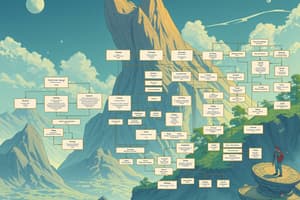Podcast
Questions and Answers
What are examples of behavioural diagrams?
What are examples of behavioural diagrams?
- Flowchart
- Activity diagram (correct)
- Use case diagram (correct)
- Entity-Relationship diagram
What type of diagram is a class diagram?
What type of diagram is a class diagram?
A structural diagram
What are class diagrams?
What are class diagrams?
A class diagram shows a collection of static model elements such as classes and types, their contents and their relationships.
Why is the class diagram one of the most important diagrams?
Why is the class diagram one of the most important diagrams?
What is the function of a class diagram?
What is the function of a class diagram?
What is a public interface?
What is a public interface?
What does a domain class diagram initially depict?
What does a domain class diagram initially depict?
What contains the entity classes that have been identified in the scope of the project and the relationship between them?
What contains the entity classes that have been identified in the scope of the project and the relationship between them?
What does an entity class represent?
What does an entity class represent?
What is the foundational diagram in the Requirements, Analysis and Design Workflows?
What is the foundational diagram in the Requirements, Analysis and Design Workflows?
What dictates the structure of the software system?
What dictates the structure of the software system?
What can be modeled by using a class diagram?
What can be modeled by using a class diagram?
What does OO stand for?
What does OO stand for?
What is the OO paradigm based on?
What is the OO paradigm based on?
Why do we form an abstraction of things?
Why do we form an abstraction of things?
Give an example of the abstraction of a person.
Give an example of the abstraction of a person.
What is the problem domain?
What is the problem domain?
What does an analysis of the specific problem domain help with?
What does an analysis of the specific problem domain help with?
What are objects?
What are objects?
What are the categories of these 'things'?
What are the categories of these 'things'?
Can these things be tangible and intangible?
Can these things be tangible and intangible?
Give an example of this.
Give an example of this.
What are 2 of the most common techniques to help us identify these entities in the problem domain?
What are 2 of the most common techniques to help us identify these entities in the problem domain?
What is the brainstorming technique?
What is the brainstorming technique?
Flashcards are hidden until you start studying
Study Notes
Behavioural Diagrams
- Examples include use case diagrams and activity diagrams.
Class Diagrams
- Class diagrams are classified as structural diagrams.
- They showcase static model elements like classes and their relationships, attributes, and behaviors.
Importance of Class Diagrams
- Essential for understanding problem domains, identifying 'things', their attributes, and behaviors.
- Serve as the central model throughout the object-oriented (OO) development life cycle, ensuring consistency with other models.
Function and Structure
- Class diagrams are continuously built and refined, acting as the focal point of OO development.
- They dictate the structure of the software system through their elements.
Public Interface
- Refers to the set of behaviors or functionalities used to interact with an object.
Domain Class Diagram
- Initially depicts a visual dictionary of key abstractions, domain vocabulary, and the content within the problem domain.
- Contains entity classes identified in the project and displays their relationships.
Entity Classes
- Represent the objects needing data storage, such as a patient with a medical record and possible prescriptions.
Requirements and Workflows
- Class diagrams are foundational in requirements, analysis, and design workflows.
Object-Orientation
- OO stands for object-oriented, which is based on a system of objects.
Abstraction
- Represents a simplified simulation of the real world to manage complexity in system design.
- Example: From a university perspective, key attributes of a person include name, address, and educational background, while medical attributes might involve heart rate and temperature.
Problem Domain
- The specific focus area of a business included in the new system's scope.
Analysis Benefits
- Helps gain an understanding of domain elements, their attributes, and behaviors.
Domain Classes
- Objects within the domain represent various "things" end users interact with.
- These "things" can be tangible (e.g., animals, books) or intangible (e.g., emotions, payments).
Practical Example
- In developing a system for COVID-19 testing, the problem domain comprises all procedures and components involved, including patients and staff, equipment, and intangible diagnoses.
Entity Identification Techniques
- Common techniques for identifying entities in a problem domain include brainstorming and noun techniques.
Brainstorming Technique
- Engages users in discussing important elements within the problem domain, considering varied perspectives of different users.
Studying That Suits You
Use AI to generate personalized quizzes and flashcards to suit your learning preferences.




